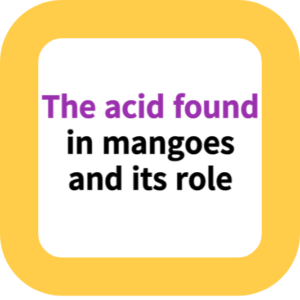The acid found in mangoes and its role
Have you ever wondered what makes mangoes so irresistibly delicious? Join us as we embark on a flavorful journey into the world of this beloved tropical fruit. Our blog is dedicated to unraveling the mysteries behind the unique taste of mangos, delving into the fascinating world of organic acids that define their flavor profile.
From the tangy zest of citric acid to the subtle tartness of malic acid, we explore how these natural compounds not only tantalize our taste buds but also contribute to the mango’s nutritional prowess. Whether you’re a mango enthusiast or a curious foodie, our blog offers intriguing insights and engaging content that will deepen your appreciation for this delectable fruit.
But there’s more to mangoes than just great taste. As we delve deeper into the composition of these tropical delights, we uncover a wealth of health benefits associated with their organic acids. Learn about how citric acid aids digestion, how malic acid plays a role in energy production, and the antioxidant properties of tartaric acid.
Our blog doesn’t just stop at the science; we also bring you creative ways to incorporate mangos into your diet, from exotic recipes to daily health tips. So, whether you’re seeking knowledge, health tips, or culinary inspiration, our blog is your go-to source for all things mango. Join us on this juicy adventure!
The acid found in mangoes and its role

Introduction: Exploring the Flavorful World of Mangos
Mangos, with their alluring yellow-orange hue and delightful sweetness, have captured the hearts of fruit lovers around the globe. Renowned for their juicy and luscious taste, these tropical fruits are also a treasure trove of nutritional benefits.
This article aims to explore the specific acids present in mangos that contribute to their unique taste and examine the health benefits and roles these acids play in our bodies.
Citric Acid: A Key Player in Mango’s Tangy Flavor
Citric acid, primarily known for its presence in citrus fruits like lemons and oranges, is also a significant component of the mango’s taste. This weak organic acid lends a refreshing tartness to the mango, creating a perfect balance with its inherent sweetness.
Beyond its role in flavor, citric acid serves as a natural preservative and is widely used in various food and beverage products to enhance taste and longevity.
Malic Acid: The Source of Mango’s Tartness
Malic acid, a dicarboxylic acid found in several fruits, including apples and grapes, is instrumental in giving mangoes their characteristic tart flavor.

This acid plays a pivotal role in the fruit’s taste, especially noticeable in unripe mangos which have higher malic acid levels, resulting in a sharper tartness. As the mango ripens, the malic acid diminishes, allowing the sweetness to become more pronounced.
The Role of Malic Acid in Metabolism and Health
Beyond its impact on flavor, malic acid is involved in critical biochemical processes in the human body. It aids in the production of energy and the metabolism of carbohydrates. In the realm of health and wellness, malic acid is used in various food additives and oral care products, appreciated for its ability to stimulate saliva and reduce oral acidity.
Tartaric Acid: Contributing to Mango’s Complex Flavor Profile
Apart from citric and malic acids, mangos also contain tartaric acid, an antioxidant found in many fruits. This acid plays a subtle yet important role in mango’s flavor, adding depth and complexity. It also contributes to the fruit’s overall health benefits, thanks to its antioxidant and anti-inflammatory properties.
The Diverse Health Benefits of Mango’s Organic Acids
The blend of organic acids in mangoes, including citric, malic, and tartaric acids, offers an array of health benefits. Citric acid is known for improving digestion and enhancing the immune system.
Malic acid, with its energy-boosting properties, is thought to improve exercise performance and reduce muscle fatigue. Tartaric acid’s antioxidant nature helps combat cellular damage and can potentially reduce the risk of chronic diseases.
Understanding the Side Effects of Malic Acid
While malic acid is generally safe and beneficial, it can have side effects when consumed in large quantities. Excessive intake can lead to digestive issues such as bloating, gas, and diarrhea. People with specific health conditions, like kidney disease or acid reflux, should monitor their malic acid intake carefully.
Conclusion: The Integral Role of Acids in Mango’s Appeal
In conclusion, the acids found in mangoes, particularly malic acid, play an integral role in defining the fruit’s distinct flavor and contributing to its health benefits. These acids not only enhance the sensory experience of eating mangos but also offer various nutritional advantages.
As with all things, moderation is key to enjoying the benefits while minimizing any potential adverse effects. Overall, the diverse organic acids in mangos make them a delicious and nutritious choice for a healthy diet.
